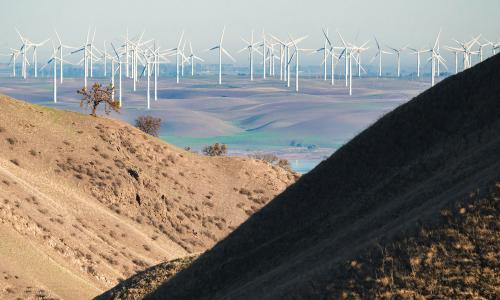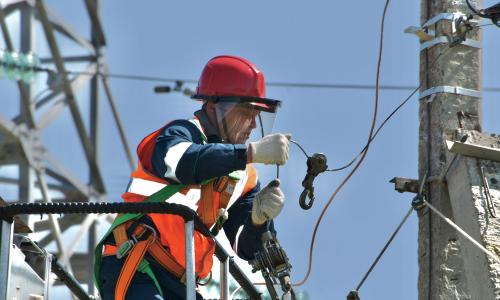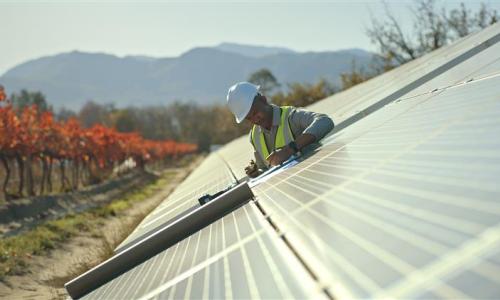Energy expert Paula Garcia talks about the growth of renewable energy across the globe and in the United States.
In this episode
- Paula discusses some of the wind and solar progress the US has made
- Colleen and Paula explore how we can transition toward clean energy technologies
- Colleen asks why energy storage is a key part of working with renewables
- Paula talks about ways energy can tie into new, well paying jobs
- Paula shares her dream for renewable energy in the future
Timing and cues
Opener (0:00-1:35)
Intro (1:35-3:22)
Interview Part 1 (3:03-14:16)
Break (14:16-14:56)
Interview Part 2 (14:56-20:24)
Sidelining Science Throw (20:24-20:30)
Sidelining Science (20:30-23:35)
Outro (23:35-24:14)
Related content
Full transcript
Colleen: Paula, welcome to the Got Science? Podcast.
Paula: Thank you so much for inviting me, Colleen.
Colleen: So, I wanna start big. What does the international landscape look like for renewable energy?
Paula: Well, it's really an impressive, amazing moment for renewable energy. Last year, solar install capacity was bigger than coal, and nuclear, and natural gas combined, just last year. And then in terms of costs, the costs of renewal energy technologies have been declining in an amazing way. Like, since 2010, solar PV costs went down more than 70%, wind more than 25%, and energy storage more than 40%. So, what we are seeing is that renewable energy is being selected as a cost-efficient technology to put in place in comparison to the traditional technologies like coal and natural gas and nuclear energy.
Colleen: So, what are the largest renewable markets?
Paula: So, I will say that based on the numbers that we have from last year, China is definitely that huge market especially for solar energy. Just last year in China, there was 53 gigawatts of solar power installed. And that was an investment of more than $86 billion. So, that's a huge market, but then we also have India. And then there are investments in other developing countries. But we are seeing that the developing world is also racing through a challenge.
Colleen: So, Paula, your background is in sustainable international development and industrial engineering. So, what do you consider the most exciting and innovative technologies out there?
Paula: Well, that's a question that I really like. So, one of those technologies is offshore wind which is new for the United States, but this is not new for Europe. Right now, in Europe we have more than 17,000 megawatts of offshore wind installed. But the case in the United States is very different. We started... The first project happened by the end of 2016 in Rhode Island. It was a project of five wind turbines producing 3 megawatts of installed capacity end of 2016. Right now, what we have is that Massachusetts has a requirement of 1,600 megawatts of capacity. New York has a requirement of 2,400 megawatts and New Jersey has a 3,500 megawatts requirement in place. So, you see how it's growing. It's growing exponentially and this is happening because the technology is showing to be effective, to be, like, the technology is showing to be cost effective, affordable, and good for economic development for the region.
Colleen: What about natural gas? So, I've heard it described as a transition fuel and at the same time it feels like some are pushing it as a long-term solution. So, what do we do with natural gas?
Paula: Well, I think that, especially a few years ago, people used to think that natural gas was really a good technology transition away from coal. The truth is that we need to transition away from fossil fuels and the investments that we are doing now in natural gas are going to lock us in for years to come. In addition, natural gas is still a fossil fuel that emits methane which is also a global warming gas. So, if we are serious about transition to clean technologies like wind and solar, natural gas is not going to take us there.
Colleen: So, what are the most exciting projects you're seeing in the U.S. and what makes them exciting?
Paula: All right. So, they are different. Like, I mentioned the different offshore wind requirements that are happening right now in the East Coast. Now, in terms of integrating large amounts of renewable energy like wind and solar because we always hear, "Oh, but wind is not always blowing and sun is not always shining." Well, guess what, we have energy storage and we can store that energy that is being produced with solar energy or wind energy. And one of the largest, if not the largest project, is located in Australia. It's 100-megawatt facility and in California there is a proposal to develop a project that is 3 times as big as that project in Australia.
So, it means that we will be able to integrate much more solar to the system through this kind of approaches. So, that's one of the things that I feel also very excited and hopeful about. And then there are other things that are happening like the transition from cars that have been traditionally fueled by gas to electric vehicles is just amazing. Like, just in 2016, we have more than 600,000 electric vehicles in U.S. roads. And energy efficiency for sure is one of those toolbox that we need to keep on having now our toolbox.
Colleen: So, going back to energy storage, that used to be a problem or a challenging aspect. So, is that there are good options for energy storage?
Paula: Well, there are a number of different options in terms of energy storage. There are like, different chemistries that you could be using. And in solar, the kind of service that you want to provide that are like, there is one of the technologies that is being most used right now is lithium-ion batteries and that's working just well in different places. So, yeah.
Colleen: So, what are the challenges to expanding renewables in the United States?
Paula: I would say that from my perspective there are two big challenges. The first one is that the federal government is not supporting and sending the message top-down that the reason that we want to have in place is to transition away from fossil fuels to renewable resources. So, for instance, at the beginning of this year, the administration of President Trump put in place solar tariffs and the uncertainty of what was going to happen with that decision created a big problem for the solar industry. I must start by saying that this solar tariff was put in place with the idea of supporting the manufacturing industry in the United States. But if you look at the industry or the solar industry in the United States, manufacturing is just a minor piece of their whole industry.
So, what has happened is that we have lost more than 10,000 jobs in the solar industry because of that decision. So, that's one of those challenges and then the other challenge is that I see that this administration wants to help the fossil fuel industry with an emphasis on coal and then it's like analyzing different possibilities like, for instance, providing some kind of subsidies or a bailout to coal plants that are very old and that are not operating economically. So, it's very strange for me to see that this administration is trying to do that because it is going to have a bad impact for the health of the people that live in this country and not just in this country for the world at large. But this is also going to hurt the pockets of the people that live here, you know. So, those kinds of things are like big challenges that are happening right now from my perspective.
Colleen: And what do you see any way we can overcome these challenges?
Paula: Absolutely. That's the exciting part of the picture and it's a helpful thing that is happening is that cities and states are racing through the challenge and showing their leadership. So, we have, for instance, at DC has a commitment of having 50% of their electricity being provided through renewable energy by the year 2032. And DC is not alone, we have Hawaii that has 100% requirement of renewable energy. California is considering to join Hawaii on this great idea to transition faster to clean energy resources. And we also have New Jersey which recently strengthened its renewable energy standard to 50% by 2030. So, let's say that that's one of those things that are exciting and that are happening right now, states showing their leadership. But not just states, we have the private sector also.
And the private sector is wanting to have access to renewable energy because of the economics. Because it's something that is affordable for them, that's something that is cost effective, and that also helps them to achieve their sustainable goals or kind of commitments they have done in terms of sustainable practices. For instance, there is no surprise in hearing that Ikea, and Google, and Apple have a commitment of like having 100% of their operation being supplied by renewable energy resources. But we also see some surprises like General Motors which is based in the Detroit. And General Motors also has a commitment of 100% renewable electricity across their global operations by the year 2050.
[Break]
Colleen: So, it looks like many of them have committed, many of the cities have committed to 2030 to have a larger percentage of renewable. Does that seem soon enough?
Paula: All right. I will respond to this in two ways. The first one is that some commitments are not for the year 2030, some commitments are for the year 2050. So, the timeline you see are longer. I think that it's a good message and I also think that we need to move faster because the issue is that there are emissions that we are not taking into account right now in the vision that we have of how much reductions in CO2 emissions we need to have in place to fulfill the Paris Climate Agreement and to avoid the worst consequences of global warming and climate change. So, we need to move faster and I hope that we are able to accomplish that. And the fact that the cost of renewable energy is being so cost competitive is something that could help to accelerate this transition.
Colleen: If I could give you a magic wand, where would you want us to be in say, five years? What is your dream for renewable energy in five years?
Paula: So, we need to have in mind the vision of where we want to go because the progress that I'm seeing right now, it's very exciting. Just the fact that I am on the street walking in my neighborhood and then I look at the roof of my neighbors, and I see solar. That's exciting if it will happen, I don't know. Ten, 15 years ago it was not that common. But we are going through a moment in which we need to be doing things in a faster fashion. So, what I would like to see, I would like to see that those fossil fuel plants that are being retired right now are being replaced...that what we used to replace them is solar energy with energy storage or wind energy, if wind energy is actually a better resource for the area where it needs to be installed. That's one of the things that I hope to see.
I hope to see that energy storage is being a larger part of the picture so that we are able to integrate larger amounts of renewable energy into the electric system. I want to see that the transportation sector gets decarbonized faster and together we need to transition faster to electric vehicles and not just for normal people like you and me, but like the public transportation sector. That's an important one. And then we need to see larger investments in energy efficiency because electricity demand is going to keep on increasing because we have larger populations and because we are trying to decarbonize our system, right? So, if we are talking about having electric vehicles, these vehicles will need to be charged.
So, we need to produce more electricity to charge those cars. So, we need to put a larger amount of renewable energy in the system faster. And also, there are two things that are very important that aren’t happening now, and hopefully in five year we’ll figure out how to do them in a better way. The first one is that we need to make sure that the clean energy provides training and job opportunities for low income communities, communities of color, so we are reflecting in the industry the communities that we are serving. And at the same time we need to make sure that the benefits of having access to renewable energy, such as wind and solar power, are reaching communities that have traditionally been underserved, like low income communities and communities of color.
And the other thing that’s also very important in this transition away from fossil fuels is that utilities, coal companies, and policy makers, engage meaningfully with key stakeholders that are being affected by this transition. For instance coal dependent communities, coal plant workers and minority and low income residents that live near the coal plants. Because we need to make sure that a good transition plans are in place before the coal plants are closed for remediation, for redevelopment and to provide local economic diversification, worker training and the creation of new, well paying jobs.
Colleen: Well, Paula, I like your vision for renewable energy. It’s all inclusive and I think that’s really important. Thank you so much for joining us on the podcast.
Paula: Thank you so much for having me.
Credits
Sidelining Science: Shreya Durvasula
Editing and music: Brian Middleton
Research and writing: Pamela Worth
Executive producer: Rich Hayes
Host: Colleen MacDonald



